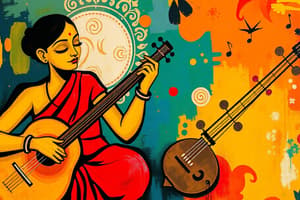Podcast
Questions and Answers
किस शास्त्रीय संगीत पर ध्यान दिया गया है जो नाट्यशास्त्र और बृहद्देशी में काफी महत्वपूर्ण है?
किस शास्त्रीय संगीत पर ध्यान दिया गया है जो नाट्यशास्त्र और बृहद्देशी में काफी महत्वपूर्ण है?
- ध्रुपद (correct)
- राग-दर्शिनी
- नाट्य-शास्त्र
- सम-वेद
किस संस्कृत शब्द से 'ध्रुपद' शब्द का अर्थ स्थिर, विश्वसनीय, या स्थिर होता है?
किस संस्कृत शब्द से 'ध्रुपद' शब्द का अर्थ स्थिर, विश्वसनीय, या स्थिर होता है?
- सुस्थिर (correct)
- स्पष्ट
- सुन्दर
- सरल
किस पुराने पाठक में संकेतिक संगीतीय प्रदर्शन तकनीकों और संगीत के निर्देशों के सबसे प्राचीन लिखित साक्ष्य है?
किस पुराने पाठक में संकेतिक संगीतीय प्रदर्शन तकनीकों और संगीत के निर्देशों के सबसे प्राचीन लिखित साक्ष्य है?
- रुद्र-हृदय
- नाट्य-शास्त्र
- रामायण
- सम-वेद (correct)
किस पुस्तक में 72 मौलिक संगीतिक स्वर, पैमाने, और तालों के विषय में चर्चा होती है?
किस पुस्तक में 72 मौलिक संगीतिक स्वर, पैमाने, और तालों के विषय में चर्चा होती है?
क्लासिकल इंडियन संगीत में कौन-कौन सी वस्तुएं प्रमुख भूमिका निभाती हैं?
क्लासिकल इंडियन संगीत में कौन-कौन सी वस्तुएं प्रमुख भूमिका निभाती हैं?
कौन-कौन सी वस्तुएं गुरु-शिष्य परंपरा के माध्यम से प्रसारित होती हैं?
कौन-कौन सी वस्तुएं गुरु-शिष्य परंपरा के माध्यम से प्रसारित होती हैं?
कैसे क्लासिकल इंडियन संगीत ने वैश्विक संगीत पर प्रभाव डाला है?
कैसे क्लासिकल इंडियन संगीत ने वैश्विक संगीत पर प्रभाव डाला है?
कैसे क्लासिकल इंडियन संगीत 'हुमान एक्सप्रेशन' की सुंदरता में नाम करता है?
कैसे क्लासिकल इंडियन संगीत 'हुमान एक्सप्रेशन' की सुंदरता में नाम करता है?
क्लासिकल इंडियन संगीत का मुख्य तत्व क्या है और इसका क्या महत्व है?
क्लासिकल इंडियन संगीत का मुख्य तत्व क्या है और इसका क्या महत्व है?
क्लासिकल इंडियन संगीत में क्या अंतर है रागा और ताला में? और इनका क्या महत्व है?
क्लासिकल इंडियन संगीत में क्या अंतर है रागा और ताला में? और इनका क्या महत्व है?
रागा में क्या महत्वपूर्ण तत्व हैं और वे किस तरह से संगीत को व्यक्त करते हैं?
रागा में क्या महत्वपूर्ण तत्व हैं और वे किस तरह से संगीत को व्यक्त करते हैं?
क्लासिकल इंडियन संगीत के रूप में क्या भाव छिपे होते हैं और क्यों इन्हें 'रंग' कहा जाता है?
क्लासिकल इंडियन संगीत के रूप में क्या भाव छिपे होते हैं और क्यों इन्हें 'रंग' कहा जाता है?
गुरु-शिष्य परंपरा क्या है और इसकी महत्वता क्या है?
गुरु-शिष्य परंपरा क्या है और इसकी महत्वता क्या है?
हिंदुस्तानी संगीत और कर्णाटक संगीत में क्या अंतर है?
हिंदुस्तानी संगीत और कर्णाटक संगीत में क्या अंतर है?
क्लासिकल इंडियन संगीत में ताल का क्या महत्व है?
क्लासिकल इंडियन संगीत में ताल का क्या महत्व है?
क्लासिकल इंडियन संगीत के भविष्य में कैसे नजर आ रहा है?
क्लासिकल इंडियन संगीत के भविष्य में कैसे नजर आ रहा है?
क्लासिकल इंडियन संगीत की विभिन्न प्रजातियों के बारे में विस्तार से बताएं।
क्लासिकल इंडियन संगीत की विभिन्न प्रजातियों के बारे में विस्तार से बताएं।
भारतीय शास्त्रीय संगीत क्यों आज भी महत्वपूर्ण है?
भारतीय शास्त्रीय संगीत क्यों आज भी महत्वपूर्ण है?
Flashcards are hidden until you start studying
Study Notes
Discovering the Timeless Melodies of Classical Indian Music
Classical Indian music, known as Hindustani and Carnatic, is a rich tapestry of melodies and rhythms that has enchanted audiences for centuries. To understand the depth of this musical tradition, let's delve into its history and the essence of classical Indian music.
Ancient Roots
The roots of classical Indian music can be traced back to ancient texts such as the Rigveda, dating back to the second millennium BCE. The Sama Veda, an ancient text that originated from the Rigveda, is believed to contain the earliest written evidence of specific musical performance techniques and compositions.
The Shastras and Dhanashree
The earliest systematic treatises on classical music, known as Shastras, date back to around the 4th century BCE. The most prominent texts in this period include the Nātya Śāstra and the Bṛhaddesī. The Nātya Śāstra is a Sanskrit treatise that provides explicit guidance on music, drama, and dance. The Bṛhaddesī is a central text in the theories of Indian music, covering topics such as the 72 fundamental musical notes, scales, and rhythms.
The Dhrupad style, one of the earliest forms of classical music, was mentioned in the Samaveda—the part of the Vedas that details ritual mantras and chants. The term "Dhrupad" is derived from the Sanskrit word "Dhruva," which means stable, reliable, or fixed. This style laid the foundation for other forms that evolved over time.
The Evolution of Ragas and Talas
Over centuries, classical Indian music evolved into the rich tapestry of ragas and talas that we know today. Ragas are melodic patterns with a particular mood, while talas are rhythmic cycles that form the backbone of Hindustani music. The evolution of ragas and talas has led to a vast repertoire of musical compositions, with each raga boasting a unique set of notes and emotions.
The Guru-Shishya Tradition
Classical Indian music, like many traditional arts, is transmitted through an apprenticeship system, known as the Guru-Shishya (master-disciple) tradition. This method has been practiced for centuries, ensuring that the music remains pure and undiluted. Under the guidance of a guru, students learn the nuances of music and its accompanying performance techniques, which hone their skills and musical intelligence.
The Global Impact
Classical Indian music has influenced global music and is celebrated and studied worldwide. The Gregorian chant, a form of Christian plainsong, borrows from the Indian ragas, as do elements of jazz, blues, and rock music. The sitar and tabla, for example, have found popularity in Western music due to their unique sound and resonance.
Classical Indian music continues to enrich our cultural landscape and offers a profound glimpse into the depth and beauty of human expression. As you delve deeper into this music, you'll find a world steeped in history and tradition that inspires and delights the senses.
Studying That Suits You
Use AI to generate personalized quizzes and flashcards to suit your learning preferences.



